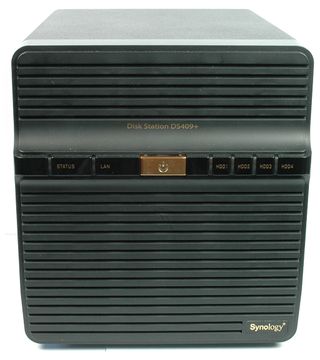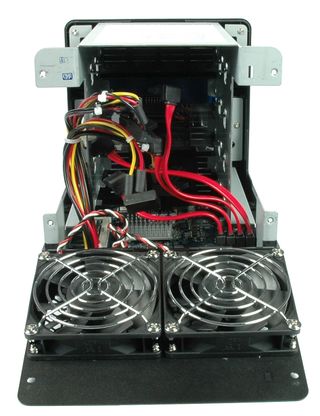Picking A Hard Drive For Your NAS: New Green Beats Old Speed
The Test Bed: Synology DS409+

For this experiment in NAS efficiency, we chose Synology’s DS409+ as our testbed. It comes equipped with 512MB of RAM, a Freescale MPC8533 CPU running at 1.06 GHz, and four drive bays. However, rather than using removable trays, the hard drives have to be installed directly in the drive cage. Two rear-mounted 80mm fans ensure that both the NAS itself and all of the drives mounted inside receive sufficient cooling.
Keeping Data Safe with RAID
Like all current NAS devices, the DS409+ features a Web-based administration interface. Here, you can select various RAID modes (namely 0, 1, 5, and 6) to increase performance, data security, or both. Additionally, other features that go beyond the basic task of providing data on a network via SMB are configured here as well.
A Multimedia and Download Server for the Home Network
On the multimedia front, these include a photo and media server that can show or play back images or audio and video files within the Web interface. There is also an integrated DLNA server (Digital Living Network Alliance) that can stream multimedia content from the NAS to other DLNA-compliant devices on the network. Finally, most current-generation NAS units can also act as a download station, supporting the most widely used protocols, such as http, https, ftp and BitTorrent.

E-Mail, Blog and CMS with your NAS
Many of the better-equipped models also offer Internet enthusiasts the option of extending their feature sets quite a bit. For example, it’s possible to equip a NAS device with an MTA (mail transfer agent), turning what was previously only your local data haven into a full-fledged mail server. Or how about this: install a MySQL server and use your NAS as the basis for your PHP-based blog or a CMS (content management system) for your Web page. At that point, you’ll be venturing back into command line territory again, though.
Stay on the Cutting Edge
Join the experts who read Tom's Hardware for the inside track on enthusiast PC tech news — and have for over 25 years. We'll send breaking news and in-depth reviews of CPUs, GPUs, AI, maker hardware and more straight to your inbox.
Current page: The Test Bed: Synology DS409+
Prev Page Build Your Own NAS Next Page Drive Choice: Performance Or Eco? Spinpoint T166 Vs. F2EG-
Is it a good comparison between 320 GB drives and 1 TB ones? Of course de 1 TB will perform better: much higher data density means less movement of heads and platters for the same amount of data. Gotta be faster. Nothing to do with the enclosure.Reply
Also I would like to mention from my own experience that heat can be a problem. I have a D-Link DNS323 and it cannot handle two server edition WD drives - it overheats.
- Bertus. -
evongugg If you buy a NAS, it's better to use the recommended drives, which have been put through hard tests.Reply
Other drives may experience RAID problems, burnout problems, etc.
If you want to salvage a NAS hard drive, you may be dealing with a Linux type partition.
-
Weird concept to compare an "old" performance drive with a new eco drive, where by default the new eco drive is outperforming the old performance drive in all categories.Reply
What is the expected result? Yes, we guessed right, the new eco drive is outperforming the old performance drive in a NAS environment.
Unfortunately that comparison does not allow any conclusion whether a NAS needs a performance drive or not, it only tells us that a new eco drive is better than an old performance drive.
Sad... -
awaken688 Totally agree with "theaxe" on this one. Not sure what this proved other than if you choice is an old performance drive vs. a new green one, choose the green one. Show me the WD 1TB Caviar Black vs. an equivalent "green" 1TB drive and then we can see more of a comparison that means something.Reply -
cknobman good thing we have the comments section so I dont wast my time reading a pointless article. first thought is "why in the f would you compare a 320gb to a 1gb?" reading the comments let me know my thought is right and not to waste time reading a pointless article.Reply -
chunkymonster ReplyOur comparison showed that the difference in write performance between faster and slower spinning hard drives is minimal to nonexistent when they are used in a NAS. Instead, the NAS’ RAID engine becomes the limiting factor.
Ok, I can understand the RAID engine being the limiting factor when using off the shelf NAS solutions, especially considering most off the shelf NAS solutions use software RAID. But, would a 5400RPM drive become the limiting factor, compared to a 7200RPM, when using a hardware RAID solution like an Areca, 3Ware, or HighPoint controller card? Any guesses? -
davidhbrown I've been reflexively buying 7200RPM drives for everything (notebooks, NAS, desktops) for so long now, that just the *concept* of the article is a useful reminder that in some settings, other issues might be important. Too bad the specific comparison may be flawed, but it's not like exactly that hardware is going to be relevant in six months anyway.Reply -
Even with a 10 watt difference, the electricity savings is negligible. At the nation average of 12 cents per kWh, using 10 less watts 24/7 for a year works out to be a whole $10.50. On the year. Less than $1 a month. A far cry from what the article stated: "the difference jumps into the two-figure range. And that can definitely make a difference when the time comes to pay your electric bill" I'll take that 88 cents I save a month and go buy...wait, what can you get for 88 cents these days?Reply
-
farrellj Just one thing...many consumer NAS boxes run a cut-down form of Linux...and Samba! And that makes it much more stable than some proprietary software that hasn't been as extensively tested as Linux/Samba has.Reply
Most Popular


